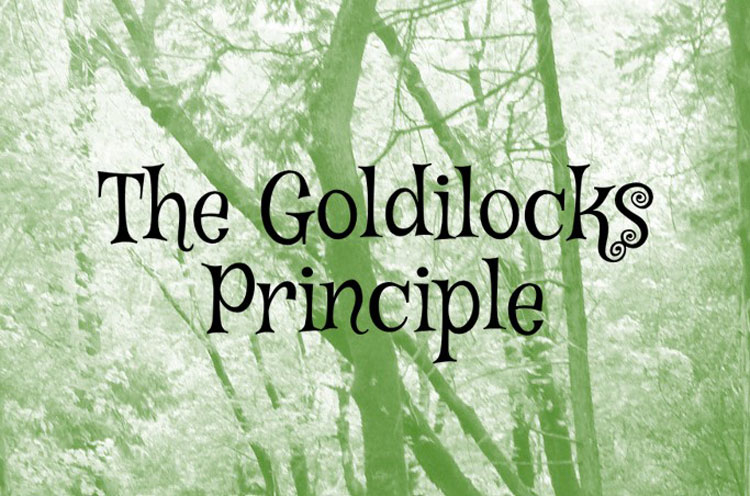Applying the Goldilocks Principle to Leadership: Striking the Perfect Balance

In the children’s fairy tale classic, “Goldilocks and the Three Bears,” the three bears in the wood prepare porridge and leave their cottage for a walk to let the hot porridge cool. The young girl, Goldilocks, enters the hut, sees the three bowls of porridge, tries each bowl, and discovers one to be too hot, one too cold, and the third just right.
This tale is a metaphor for the delicate balance in many realms, from cognitive science to developmental psychology and astrobiology to economics—the notion of achieving a state that is “just right.” It is about creating an optimal condition for success. It has even found its place in machine learning, where the Goldilocks learning rate is defined as that in an algorithm that results in a minimal loss.
The Goldilocks principle resonates significantly within the realm of leadership practices. By embracing the delicate art of balance, leaders can unlock new dimensions of effectiveness and impact.
In this article, I highlight five critical areas where applying this principle can elevate leadership practices from adequate to exceptional.
- Lots of Meetings or No Meetings?
The Wall Street Journal recently reported, “Since announcing a temporary purge of some kinds of meetings in early January, Shopify has deleted 12,000 events from staffers’ calendars, freeing up some 95,000 hours.”Can you do away with meetings altogether? Not really. You need them for various reasons, including collaborating and informing. But can you do some of this offline? Absolutely. Often emails and Slack channels will suffice.
The Goldilocks meeting principle is not to have too many or too few. If you start with the questions of what the agenda is, who needs to be involved, and limit the duration of the meeting to be productive, you can achieve the balance.
- Strategy or Execution?
Winston Churchill said, “However beautiful the strategy, you should occasionally look at the results.” A 2013 report, “Why good strategies fail: Lessons for the C-suite,” cites a survey of 587 senior executives. It reports that 61% of respondents say it is a struggle to “bridge the gap between strategy formulation and its day-to-day implementation.” Outstanding leaders pay as much attention to how a strategy can be executed as they do to the strategy itself.A well-executed strategy requires breaking it down into executable actions and goals at every level in the organization. It requires that the responsibilities are well-defined and have clear priorities. It has well-defined metrics to understand the performance of execution to plan.
Many leaders tend to pay attention to strategy, completely forgetting to ensure it is executed well. Good leaders understand that winning strategies require revisiting as your execution progresses. They look at metrics of execution and recalibrate the plans. And they keep the stakeholders abreast of any changes.
- Confidant or Humble?
Leaders need to project an image of being confident during times of trouble. Many leaders believe they must have all the answers and think they know better. In today’s complex world, no individual has all the answers. The leaders who recognize this solicit input from various sources to make better decisions. They admit they can use help and use the phrase, “We are all in this together.” They can lead better than those who don’t.Great leaders can convey their confidence while remaining humble.
Adam Grant, The Saul P. Steinberg Professor of Management and Psychology at Wharton, recommends a “Nano-Tool” for leaders called Confident Humility. He says, “Confident humility allows you to believe in yourself while questioning your strategies.” He prescribes three actions for leaders to develop confident humility:
a. Create a learning culture: Foster a psychologically safe place to learn by questioning the norm and experimenting.
b. Give yourself the benefits of doubt: Consider yourself a novice, question what you know, and seek new insights.
c. Identify conflicting information or opinion: Actively look for evidence that you may be wrong. Ask, “How do you know?” and “What if we’re wrong?”Success is achievable when you are confidently humble.
- Stress or No Pressure?
The 1908 study conducted by psychologists Robert Yerkes and John Dillingham Dodson on mice led to the Yerkes-Dodson Law, the relationship between stress and performance. It has been used to explain how you need some pressure to perform well, for example, in competitive sports, test-taking and public speaking. Too much stress leaves one inactive, whereas the optimal amount of stress results in peak performance.One needs and can tolerate stress to deliver superior performance as a leader. However, too much pressure can render you useless. For this reason, one has to find ways to manage stress with coping mechanisms and have a robust support system that can help in times of too much pressure.
The Goldilocks principle for stress is to have enough of it to push oneself to achieve performance and not too much that it renders one unable to function.
- Attention to Tasks or Attention to People?
I was wholly focused on the tasks of managing a team as a software leader in my early days. Did we meet the release dates? Did we achieve the performance targets? How many defects were discovered by customers? The team members who did well in my team were like me—focused on results.A 360-degree assessment helped me see my shortcomings as a leader, and a leadership coach helped me see the need to balance attention to tasks and people.
Over time, I learned to balance attention to tasks with attention to the team that performs the duties. Is every member of the group learning something new? Are the team members’ individual jobs preparing them for the next step in their careers? Are they empowered to do their best in executing the tasks?
Ask yourself if you are focusing too much on the tasks and not enough on the members of your team.
An organization’s performance is equal to the sum of the performance of its people. As such, discover what makes them tick and learn about their strengths and weaknesses. Reward the strengths, and address the weaknesses with coaching and training. Use informal communication to listen to your team and act on what you heard. Outstanding leaders can take organizational goals and break them down into goals individuals can own.
Empower your team to do their very best.
Find the “just-right” balance between attention to task and people to be a brilliant leader.
Striking The Perfect Balance
As a leader, you have to navigate many tensions in your career. There are instances where the decisions you make have to be just right. I provided five of them for you to think about. Learn to navigate your decision-making by applying the Goldilocks principle.
Written by Shantha Mohan.
Have you read?
Top Women CEOs of America’s largest public companies (2023 List).
CEOs Of The Top Footwear Companies You Should Know.
Top CEOs of the World’s Largest Media Companies In 2023.
Best International High Schools In The World, 2023.
Revealed: The World’s Best Airline CEOs, 2023.
Bring the best of the CEOWORLD magazine's global journalism to audiences in the United States and around the world. - Add CEOWORLD magazine to your Google News feed.
Follow CEOWORLD magazine headlines on: Google News, LinkedIn, Twitter, and Facebook.
Copyright 2025 The CEOWORLD magazine. All rights reserved. This material (and any extract from it) must not be copied, redistributed or placed on any website, without CEOWORLD magazine' prior written consent. For media queries, please contact: info@ceoworld.biz








